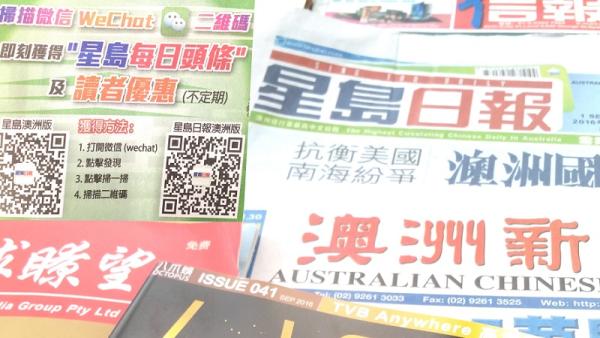Chinese-language media in Australia: an opportunity for Australian soft power

Professor Wanning Sun is Professor of Media and Communication in the Faculty of Arts and Social Sciences at UTS. |
More than ever before, Australia is wedged between its economic dependence on China and its security alliance with the US. How the Chinese-language media in Australia figures in this fraught relationship is no longer just an academic question.
Some have argued that the sector has become a key tool for China to exert soft power and influence in Australia.
But understanding this sector is difficult for outsiders: there is the language barrier obviously, and also the fact that Chinese-language media is distributed on platforms that most Australians are unfamiliar with, particularly those in the digital realm.
In an attempt to shed light on the sector’s current composition and role, I was commissioned by the Australia-China Relations Institute (ACRI) at the University of Technology Sydney to write a major research report on the topic. The report draws on a decade of academic research and experience observing Chinese-language media in Australia.
The report, released today, begins by identifying a profound transformation. No longer is Chinese-language media dominated by outlets catering to earlier Cantonese-speaking generations. Nowadays a vibrant media landscape has emerged that targets a Mandarin-speaking migrant community from the People’s Republic of China (PRC).
Accompanying this shift in consumer demographic has been a discernible shift from a mostly critical coverage of China to a mostly supportive stance. This shift dovetails with the ‘going global’ expansionist initiatives of the Chinese state media, which have become to some extent integrated with Chinese media in Australia.
That said, there is little clear evidence that such ‘localised’ propaganda has a direct impact on Chinese-speaking audiences, let alone the broader Australian community.
Chinese migrants tend to harbour an innate scepticism or even indifference towards state media.
Better educated migrants also access news and current affairs from a range of sources, and local Chinese media are at best only one of these sources.
The circulation of Chinese newspapers in Australia is also relatively small. Chinese-speaking migrants can easily access or be exposed to propaganda content from PRC media directly, so their exposure to it in diasporic Chinese-language media may only be a marginal factor in the formation of their views.
The notion that the Chinese-language media in Australia has been ‘bought off’, ‘taken over’, or is owned or directly controlled, by China’s propaganda authorities is also simplistic.
Yet for all the reassurance this provides the report identifies a major blind spot in Australia’s current understanding of Chinese-language media. Specifically, while most current concerns are directed toward the impact of China’s propaganda on the diasporic Chinese newspapers and Australia’s rights to freedom of expression, the social and national interest implications of an emerging online media run by mostly student migrants have been underestimated.
In domestic politics, Chinese-language online media, particularly social media, have helped major parties to win Chinese votes. But they have also fanned Chinese nationalist sentiments, mostly siding with China if there is a potential clash between the two nations on matters of national pride, sovereignty and territoriality.
This online space has also become a popular forum for the Chinese migrant students to express palpable frustration, even anger, with Australia’s perceived tendency to follow the United States in its foreign policy towards China.
A Chinese migrant in Australia is simultaneously targeted by China’s state media, Chinese migrant media, the Chinese-language media provided as part of Australia’s multicultural media service (SBS) and mainstream English-language Australian media. The tensions and dilemmas facing individuals from the Chinese migrant community become at best a source of cultural anxiety and frustration, at worst a trigger for social disharmony.
This can be particularly worrisome when Australia’s mainstream commercial/tabloid media display cultural insensitivity towards China, or even worse, pander to racist sentiments in their coverage of China or the Chinese in Australia.
But there is a bright side to the huge expansion in the use and influence of Chinese online and social media: it is not the exclusive domain of the Chinese government to spurt propaganda or give fuel to nationalist sentiment.
The Australian government, for example, could take the opportunity to use Chinese online media to exert Australian soft power and explain its position on controversial matters such as the South China Sea dispute.
Likewise, Chinese social media are extremely powerful tools for networking with Chinese business individuals, promoting Australian brand names and products, identifying trade and investment opportunities, and targeting the Chinese population in order to grow one’s business clientele. Yet due to cultural and linguistic barriers the mainstream Australian business sector has been slow to take advantage of what Chinese social media such as WeChat has to offer.
The report finishes with a series of recommendations for the government, business, and Australia’s mainstream media sector.
The government needs to take steps to ensure that migrant media become integral parts of a genuinely multicultural, multilingual mainstream media landscape, rather than ‘ethnic media’ that exist in parallel silos to the English-language media.
It must also develop strategies for using Chinese-language media to generate good will within Australia’s Chinese community, and to cultivate an understanding, if not acceptance, of Australia’s national interests in relation to China.
One step could be to provide incentivising schemes aiming at encouraging bilingual content production, facilitating cross-cultural training and exchange for staff, and generating dialogue and debate.
For business sector wishing to access the Chinese market, it is crucial to target Chinese social media platforms (in particular, WeChat) to explore business opportunities and seek to expand clientele in the Chinese community (in both Australia and mainland China) by recruiting bilingual staff or engaging specialist consultants with relevant linguistic, cultural and technological skills and knowledge.
Rather than an irksome gesture at tolerance and inclusion, mainstream Australian media, marketing, and public relations organisations should see cultural diversity in the workforce as a potential resource. They need to implement media recruitment policies and strategies that specifically seek out employees with native or near-native Chinese language skills, knowledge of Chinese media/business/government practices, and an understanding of Chinese culture generally.
Download Professor Sun's report 'Chinese-language media in Australia: Developments, challenges and opportunities' here.
Author
Wanning Sun, Professor of Media and Communication, Faculty of Arts and Social Sciences, University of Technology Sydney. Professor Sun specialises in Chinese media and communication, rural to urban migration and cultural politics of inequality in contemporary China, and diasporic Chinese media.

